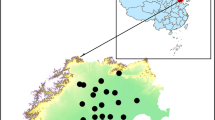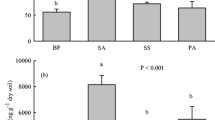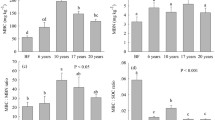Abstract
Plant invasion has been reported to affect a mass of soil ecological processes and functions, although invasion effects are often context-, species- and ecosystem- specific. This study was conducted to explore potential impacts of Praxelis clematidea invasion on contents of total and available soil nitrogen (N) and microbial N transformations in a tropical savanna. Soil samples were collected from the surface and sub-surface layers in plots with non-, slight, or severe P. clematidea invasion in Hainan Province of southern China, which remains less studied, and analyzed for contents of the total and available N fractions and microbial N transformations. Results showed that total N content significantly increased in the surface soil but trended to decrease in the sub-surface soil in the invaded plots relative to the non-invaded control. Slight invasion significantly increased soil alkali-hydrolysable N content in the two soil layers. Soil net N mineralization rate was not significantly changed in both the soil layers, although soil microbial biomass N was significantly higher in plots with severe invasion than the control. There was no significant difference in content of soil N fractions between plots with slight and severe invasion. Our results suggest that invasion of P. clematidea promotes soil N accumulation in the surface soil layer, which is associated with increased microbial biomass N. However, the invasion-induced ecological impacts did not increase with further invasion. Significantly higher microbial biomass N was maintained in plots with severe invasion, implying that severe P. clematidea invasion may accelerate nutrient cycling in invaded ecosystems.




Similar content being viewed by others
References
Bao S (2000) Agro-chemical analyses of soils. China Agruculture Press, Beijing
Bardgett RD, van der Putten WH (2014) Belowground biodiversity and ecosystem functioning. Nature 515:505–511. doi:10.1038/Nature13855
Bradley BA, Early R, Sorte CJB (2015) Space to invade? Comparative range infilling and potential range of invasive and native plants. Glob Ecol Biogeogr 24:348–359
Brookes PC, Landman A, Pruden G, Jenkinson DS (1985) Chloroform fumigation and the release of soil nitrogen: a rapid direct extraction method to measure microbial biomass nitrogen in soil. Soil Biol Biochem 17:837–842
Burger M, Jackson LE (2003) Microbial immobilization of ammonium and nitrate in relation to ammonification and nitrification rates in organic and conventional cropping systems. Soil Biol Biochem 35:29–36
Burke MJW, Grime JP (1996) An experimental study of plant community invasibility. Ecology 77:776–790
Callaway RM, Ridenour WM (2004) Novel weapons: invasive success and the evolution of increased competitive ability. Front Ecol Environ 2:436–443. doi:10.1890/1540-9295(2004)002[0436:Nwisat]2.0.Co;2
Callaway RM, Thelen GC, Rodriguez A, Holben WE (2004) Soil biota and exotic plant invasion. Nature 427:731–733. doi:10.1038/Nature02322
Carey CJ, Beman JM, Eviner VT, Malmstrom CM, Hart SC (2015) Soil microbial community structure is unaltered by plant invasion, vegetation clipping, and nitrogen fertilization in experimental semi-arid grasslands. Front Microbiol 6:466. doi:10.3389/fmicb.2015.00466
Christian JM, Wilson SD (1999) Long-term ecosystem impacts of an introduced grass in the northern Great Plains. Ecology 80:2397–2407
Cotrufo MF, Wallenstein MD, Boot CM, Denef K, Paul E (2013) The microbial efficiency-matrix stabilization (MEMS) framework integrates plant litter decomposition with soil organic matter stabilization: do labile plant inputs form stable soil organic matter? Glob Chang Biol 19:988–995. doi:10.1111/gcb.12113
Dukes JS, Mooney HA (1999) Does global change increase the success of biological invaders? Trends Ecol Evol 14:135–139
Ehrenfeld JG (2003) Effects of exotic plant invasions on soil nutrient cycling processes. Ecosystems 6:503–523. doi:10.1007/s10021-002-0151-3
Evans RD, Rimer R, Sperry L, Belnap J (2001) Exotic plant invasion alters nitrogen dynamics in an arid grassland. Ecol Appl 11:1301–1310
Hooper DU et al (2000) Interactions between aboveground and belowground biodiversity in terrestrial ecosystems: patterns, mechanisms, and feedbacks. Bioscience 50:1049–1061. doi:10.1641/0006-3568(2000)050[1049:IBAABB]2.0.CO;2
Hulme PE, Pysek P, Jarosik V, Pergl J, Schaffner U, Vila M (2013) Bias and error in understanding plant invasion impacts. Trends Ecol Evol 28:212–218. doi:10.1016/j.tree.2012.10.010
Jandova K, Klinerova T, Mullerova J, Pysek P, Pergl J, Cajthaml T, Dostal P (2014) Long-term impact of Heracleum mantegazzianum invasion on soil chemical and biological characteristics. Soil Biol Biochem 68:270–278. doi:10.1016/j.soilbio.2013.10.014
Knops JMH, Bradley KL, Wedin DA (2002) Mechanisms of plant species impacts on ecosystem nitrogen cycling. Ecol Lett 5:454–466. doi:10.1046/j.1461-0248.2002.00332.x
Kuebbing SE, Classen AT, Simberloff D (2014) Two co-occurring invasive woody shrubs alter soil properties and promote subdominant invasive species. J Appl Ecol 51:124–133. doi:10.1111/1365-2664.12161
Liao C et al (2008) Altered ecosystem carbon and nitrogen cycles by plant invasion: a meta-analysis. New Phytol 177:706–714. doi:10.1111/j.1469-8137.2007.02290.x
Luo YQ, Hui DF, Zhang DQ (2006) Elevated CO2 stimulates net accumulations of carbon and nitrogen in land ecosystems: a meta-analysis. Ecology 87:53–63. doi:10.1890/04-1724
MacKown CT, Jones TA, Johnson DA, Monaco TA, Redinbaugh MG (2009) Nitrogen uptake by perennial and invasive annual grass seedlings: nitrogen form effects. Soil Sci Soc Am J 73:1864. doi:10.2136/sssaj2008.0334
Marris E (2009) The end of the invasion? Nature 459:327–328
Martina JP, Hamilton SK, Turetsky MR, Phillippo CJ (2014) Organic matter stocks increase with degree of invasion in temperate inland wetlands. Plant Soil 385:107–123. doi:10.1007/s11104-014-2211-9
Masunga RH, Uzokwe VN, Mlay PD, Odeh I, Singh A, Buchan D, De Neve S (2016) Nitrogen mineralization dynamics of different valuable organic amendments commonly used in agriculture. Appl Soil Ecol 101:185–193. doi:10.1016/j.apsoil.2016.01.006
McDougall KL, Morgan JW, Walsh NG, Williams RJ (2005) Plant invasions in treeless vegetation of the Australian alps perspectives in plant ecology. Evolution and Systematics 7:159–171. doi:10.1016/j.ppees.2005.09.001
Ogle SM, Ojima D, Reiners WA (2004) Modeling the impact of exotic annual brome grasses on soil organic carbon storage in a northern mixed-grass prairie. Biol Invasions 6:365–377. doi:10.1023/B:Binv.0000034629.68660.28
Richardson DM, Pyšek P (2006) Plant invasions: merging the concepts of species invasiveness and community invasibility. Prog Phys Geogr 30:409–431
Roberts TL, Norman RJ, Slaton NA, Wilson CE (2009) Changes in alkaline Hydrolyzable nitrogen distribution with soil depth: fertilizer correlation and calibration implications. Soil Sci Soc Am J 73:2151–2158. doi:10.2136/sssaj2009.0089
Sardans J, Peñuelas J (2012) The role of plants in the effects of global change on nutrient availability and stoichiometry in the plant-soil system. Plant Physiol 160:1741–1761. doi:10.1104/pp.112.208785
Seastedt TR, Pyšek P (2011) Mechanisms of plant invasions of north American and European grasslands. Annu Rev Ecol Evol S 42:133–153. doi:10.1146/annurev-ecolsys-102710-145057
Skurski TC, Rew LJ, Maxwell BD (2014) Mechanisms underlying nonindigenous plant impacts: a review of recent experimental research. Invasive Plant Science and Management 7:432–444. doi:10.1614/Ipsm-D-13-00099.1
Souza-Alonso P, Novoa A, Gonzalez L (2014) Soil biochemical alterations and microbial community responses under Acacia dealbata link invasion. Soil Biol Biochem 79:100–108. doi:10.1016/j.soilbio.2014.09.008
Stanford G, Smith SJ (1972) Nitrogen mineralization potentials of soils. Soil Sci Soc Am J 36:465–472. doi:10.2136/sssaj1972.03615995003600030029x
Sun Y, Muller-Scharer H, Schaffner U (2014) Plant neighbours rather than soil biota determine impact of an alien plant invader. Funct Ecol 28:1545–1555. doi:10.1111/1365-2435.12295
te Beest M, Stevens N, Olff H, van der Putten WH (2009) Plant-soil feedback induces shifts in biomass allocation in the invasive plant Chromolaena odorata. J Ecol 97:1281–1290. doi:10.1111/j.1365-2745.2009.01574.x
te Beest M, Esler KJ, Richardson DM (2015) Linking functional traits to impacts of invasive plant species: a case study. Plant Ecol 216:293–305. doi:10.1007/s11258-014-0437-5
Turner MG, Smithwick EA, Metzger KL, Tinker DB, Romme WH (2007) Inorganic nitrogen availability after severe stand-replacing fire in the greater Yellowstone ecosystem. Proc Natl Acad Sci U S A 104:4782–4789. doi:10.1073/pnas.0700180104
USDA (2014) Weed risk assessment for Praxelis clematidea R. M. King & H. Rob. (Asteraceae) - Praxelis
van der Putten WH, Klironomos JN, Wardle DA (2007) Microbial ecology of biological invasions. ISME J 1:28–37. doi:10.1038/Ismej.2007.9
van der Putten WH et al (2013) Plant-soil feedbacks: the past, the present and future challenges. J Ecol 101:265–276. doi:10.1111/1365-2745.12054
Wang QZ, Huang M, Downie SR, Chen ZX, Chen YT (2015) Genetic diversity and structure of the noxious alien grass Praxelis clematidea in southern China. Biochem Syst Ecol 59:183–189
Wardle DA, Bardgett RD, Klironomos JN, Setala H, van der Putten WH, Wall DH (2004) Ecological linkages between aboveground and belowground biota. Science 304:1629–1633
Waterhouse BM (2003) Know your enemy: recent records of potentially serious weeds in northern Australia. Papua New Guinea and Papua (Indonesia) Telopea 10:477–485
Weber E, Sun SG, Li B (2008) Invasive alien plants in China: diversity and ecological insights. Biol Invasions 10:1411–1429
Weidenhamer JD, Callaway RM (2010) Direct and indirect effects of invasive plants on soil chemistry and ecosystem function. J Chem Ecol 36:59–69. doi:10.1007/s10886-009-9735-0
Wolkovich EM, Lipson DA, Virginia RA, Cottingham KL, Bolger DT (2010) Grass invasion causes rapid increases in ecosystem carbon and nitrogen storage in a semiarid shrubland. Glob Chang Biol 16:1351–1365. doi:10.1111/j.1365-2486.2009.02001.x
Wu J, Joergensen RG, Pommerening B, Chaussod R, Brookes PC (1990) Measurement of soil microbial biomass C by fumigation-extraction-an automated procedure. Soil Biol Biochem 22:1167–1169
Xiao HF, Feng YL, Schaefer DA, Yang XD (2014) Soil fungi rather than bacteria were modified by invasive plants, and that benefited invasive plant growth. Plant Soil 378:253–264. doi:10.1007/s11104-014-2040-x
Acknowledgments
Anonymous reviewers are appreciated to help us improve our manuscript, with good suggestion on the data process and discussion. This research was funded by the Doctoral Fund of Ministry of Education of China (No. 20124404110009), Foundation for High-level Talents in Higher Education of Guangdong, China ([2013] No. 246), Science and Technology Program of Guangdong Province, China (No. 2015B090903077 and 2015A020215021), and the National Natural Science Foundation of China (No. 31500401).
Author information
Authors and Affiliations
Corresponding author
Additional information
Responsible Editor: Zhihong Xu
Rights and permissions
About this article
Cite this article
Wei, H., Xu, J., Quan, G. et al. Effects of Praxelis clematidea invasion on soil nitrogen fractions and transformation rates in a tropical savanna. Environ Sci Pollut Res 24, 3654–3663 (2017). https://doi.org/10.1007/s11356-016-8127-6
Received:
Accepted:
Published:
Issue Date:
DOI: https://doi.org/10.1007/s11356-016-8127-6




